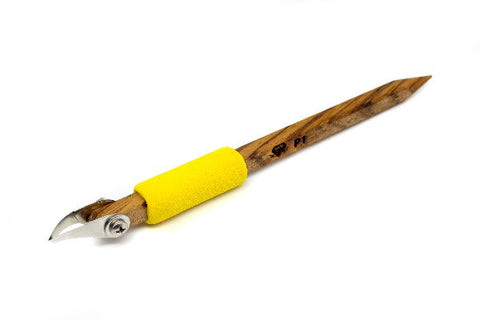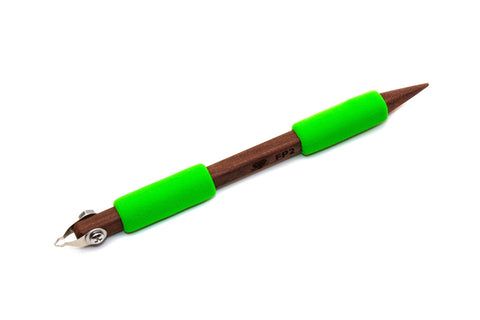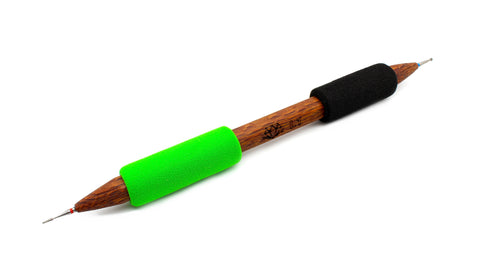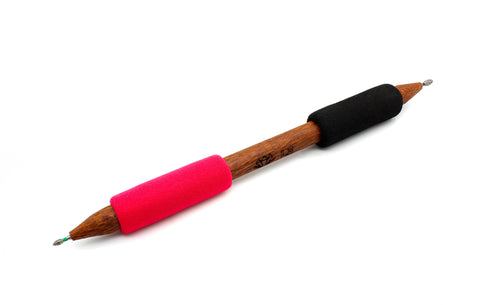Uses for Clay Slip You Probably Haven’t Thought Of
You probably remember clay slip as the go-to solution for joining pieces together, but it’s capable of so much more. From adding rich texture to repairing greenware and bringing unique finishes to life, slip is a powerful tool in any potter’s kit. In this post, we’re diving into some fresh, creative ways to use clay slip that you might not have tried yet, along with tips to help you get the most out of every project.
What Is Clay Slip?
Clay slip is simply clay mixed with water until it’s smooth and creamy.
Here’s what you need to know:
-
You control the thickness
-
Thin slip is great for casting or painting.
-
Thick slip works well for joining clay or adding texture.
-
Thin slip is great for casting or painting.
-
You can add deflocculants
- These help the slip flow better without needing too much water.
-
It’s versatile
- Whether you're hand-building, decorating, or casting, the right slip can make all the difference in your process.
Clay slip is one of those simple tools that opens the door to a lot of creative possibilities.
Clay Slip for Joining Pieces of Pottery
Clay slip can be used to join many pieces of pottery together. One of the most popular examples of this is when attaching a handle to a mug. This is done by creating small scratches where you want to connect the two pieces together, also called “scoring” the clay, adding slip to both sides, then gently pressing them together. This will help to create a bond between the two pieces of clay, keeping them together once dried.
As a tip, it’s important that the slip being used has the same clay body as the piece to which you are attaching it. Because of this, it’s recommended that the potter make the slip instead of buying it.
Pottery Scoring Tools:
Most of our tools can be flipped to use the non-blade end to score your clay.
Take a look at a few of our most popular clay carving tools for scoring below!
P1 Curved V Tip Carving Tool
The P1 Curved V Tip Carving Tool is a must-have pencil-point carving tool for any ceramic artist’s collection.
This pottery tool features DiamondCore® advanced blade technology, so your blade never dulls, and it’s easy to craft clean, crisp lines every time!
P1 CURVED V TIP CARVING TOOL - $38
P26 Long Diamond Relief-Carving Tool
Looking for a great ceramic carving tool to remove material? Our P26 Long Diamond Relief-Carving Tool will be a priceless addition to your pottery carving tool collection.
P26 LONG DIAMOND RELIEF-CARVING TOOL - $38
FP2 Fine Point Arrow Carving Tool
With its arrow-shaped blade, the FP2 Fine Point Arrow Carving Tool is perfect for carving in multiple directions and angles within a tight space.
Make clean, crisp, fine lines with the tip of the blade, and with a slight twist of the tool, the wider part of the blade can shave off a wider strip.
FP2 FINE POINT ARROW CARVING TOOL - $38
Clay Slip for Decorating
Often, we only think of using slip as a pottery joining tool, but it can also be used for decorating the body of your piece as well. Your pieces can be dipped into a colored slip, or you can paint your slip on.
To create colored slip, mix metal oxides with it to create the color of your choice. Some other options include flashing slips and slip trailing. Flashing slip creates an organic look that is created within the kiln. Since kilns are more consistent throughout the firing process, flashing slips can be used to paint over the pottery using a mixture of alumina reacting in an atmosphere of salt and ash.
Each piece will come out of the kiln with different colors, creating a surprise for you as you wait for your piece to be finished! Slip trailing is when the slip is mostly clay and can then be applied to an almost-finished piece. Sometimes artists will use a bulb syringe that can push out the slip in a controlled way. But you can choose to create your piece of pottery any way you see fit!
Pottery Decorating Tools
These DiamondCore Stylus tools are helpful for carving into underglaze or slip with precision and ease.
L1 Diamond Sgraffito Stylus Tool - Needle / 1.2 mm Ball
L1 DIAMOND SGRAFFITO STYLUS TOOL - $48
L2 Diamond Sgraffito Stylus Tool - 2.5 mm Crown / 0.7 mm Ball
L2 DIAMOND SGRAFFITO STYLUS TOOL - $48
L3 Diamond Sgraffito Stylus Tool - Large Football / Small Football
L3 DIAMOND SGRAFFITO STYLUS TOOL - $48
Clay Slip for Protection and Efficiency
Some slip will harden as it dries, so you can also use slip to protect your pottery pieces!
Slip casting is a way for you to duplicate ceramic pieces by pouring slip into a plaster mold and then waiting overnight until it becomes leather-hard. Once it is at this point, it can come out of the mold to then be fired. The mold can then be rinsed out and used again to create the same ceramic piece over and over.
More Creative Ways to Use Clay Slip
Slip is more than just a practical staple in your studio. It can also be a great source of inspiration. If you're ready to experiment, here are some of our favorite creative ways to use clay slip that go beyond the basics!
Sgraffito with Slip Layers
Brush a layer of colored slip onto leather-hard clay and let it set slightly. Then carve into the surface to reveal the clay underneath. This adds sharp, detailed decoration that really stands out, especially when paired with a precise stylus tool.
Crackle Effects with Thick Slip
Apply a thick coat of slip and allow it to dry on its own. As it shrinks, it creates natural cracks that give your piece a textured, aged look. You can even layer different colored slips for extra depth.
Repairing Greenware
If you spot a small chip or a hairline crack, don’t worry. Mix up some thick slip using the same clay body and patch the area. Smooth it out and let it dry slowly before firing.
Slip as Watercolor Paint
Thin your slip and mix in a bit of stain or oxide. You can then brush it onto leather-hard clay like a watercolor to add soft, flowing effects before the piece is fired.
3D Printing with Clay Slip
Some ceramic artists are using clay slip in 3D printers to build complex forms, one layer at a time. This is a fun way to combine traditional materials with new technology.
If you’re exploring the tech side of ceramics, clay slip is used in many 3D printers for building complex forms layer by layer. It’s an exciting way to blend tradition with innovation in your studio.
For those exploring ceramic 3D printing, thickened slip is the go-to material for many machines. This process allows you to create complex forms that might be hard to build by hand.
Clay Slip Pottery Ideas
Slip is a great tool for you to connect pieces of pottery together, create unique decorations, or help build protection for your piece. If you store your slip properly, you will be able to use it for a long time. Store your slip in an airtight container; Ziplock bags work great to keep air out and prevent mold. A little vinegar will also help bleach your slip to clear out any mold beginning to grow.
If you have any questions when it comes to clay slip or choosing the right pottery tools for your project, we’re here to help! Leave a comment here on the blog, send us an email or get in touch with our team on social media — we’re on Facebook and Instagram!
FAQs About Clay Slip
Can I make clay slip at home?
Yes! Just mix dry clay scraps or trimmings with water until it reaches a smooth, creamy consistency. For best results, use the same clay body as your project.
How do I add color to clay slip?
You can add ceramic stains, oxides, or pigments to your slip to create custom colors. Always test on a sample piece to see how the color changes after firing.
Can slip be used on bisqueware?
Slip is typically applied to greenware, but some potters experiment with specially formulated slips or underglaze-like effects on bisqueware. Always test before committing to a full piece.
How do I store clay slip properly?
Keep your slip in an airtight container, like a lidded bucket or a heavy-duty Ziplock bag. To prevent mold, add a splash of vinegar or a few drops of bleach.
Can slip go into the kiln as-is?
Yes, once the piece is dry and properly prepped, the slip will fire along with your clay. Just be sure the slip is fully dry and compatible with your firing schedule.









Leave a comment